NOTE: Bloomberg Second Measure launched a new and exclusive transaction dataset in July 2022. Our data continues to be broadly representative of U.S. consumers. As a result of this panel change, however, we recommend using only the latest posts in assessing metrics, and do not support referring to historical blog posts to infer period-over-period comparisons.
The future is now—or at least it was this month—when the biggest players in consumer technology came together at the annual CES conference to share, among other things, the latest in self-driving cars. Autonomous vehicles hitting the road will shake up the landscape of existing car services, which has already seen some high-profile entrants in the last couple decades. But which companies are true disruptors? Buckle up, because we’re about to take a look at where the U.S. industry stands—for now.
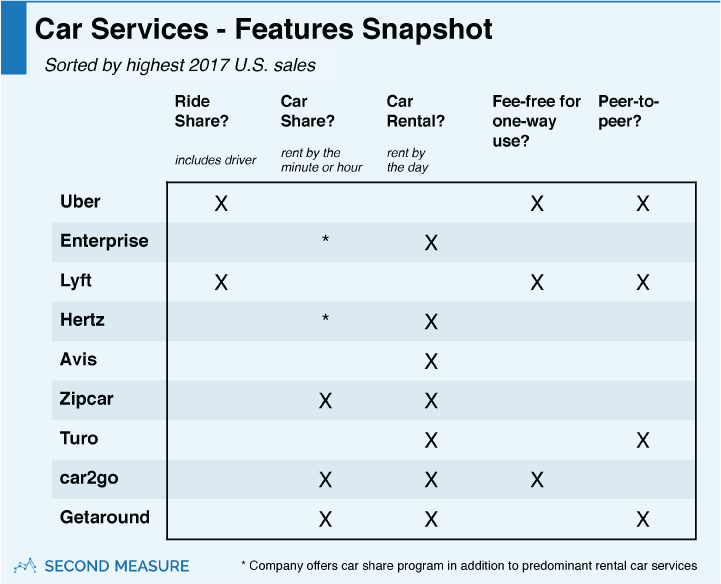
Some people are using Uber, Lyft—and one other startup—to replace their personal vehicles
One in four people have tried Uber and, while that’s certainly a noteworthy accomplishment, it’s even more fascinating to see the extent to which they use it. Ten percent of those riders use Uber at least 50 times a year—nearly once a week. There are fewer than 30 other major companies in the United States that can say the same, and most of those are grocery stores or mega-retailers, like Amazon and Walmart.
Despite impressive usage, Uber still faces the looming possibility that scaling its business may never lead to profitability. But there’s certainly hope for Uber that, after years of leading the ride-hailing market at a loss, the advent of self-driving cars could be a turning point.
While most of us wait for this taxi-sans-driver service of the future, it already exists in seven U.S. cities. Car2go rents cars for one-way use, essentially allowing you to drive your own taxi and leave it parked at your destination when you’re done. And, like Uber, its best customers are highly engaged—10 percent use car2go more than 50 times a year.
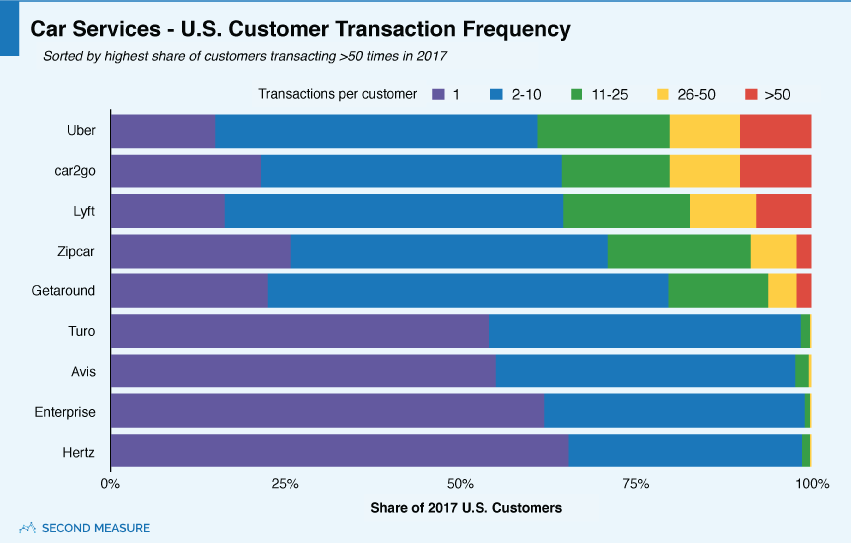
Car2go is owned by German automotive behemoth Daimler, which manufacturers car2go’s fleet of Smart Cars and Mercedes-Benzes. Though its footprint is small, car2go has a healthy proportion of high-frequency users. In fact, 1 percent of car2go customers transact over 200 times per a year, using the service as often as they might use a personal vehicle. Uber and Lyft have a similar fraction of customers doing the same.
The high percentage of habitual car2go customers is often a hallmark of a good product, but the company has still seen some bumpy roads. Car2go actually lost customers over the past two years, due in part to exiting from two West-Coast markets in 2015 and three other U.S. cities in 2016. By the end of 2017, car2go had 27 percent fewer U.S. customers than at the start of 2015.
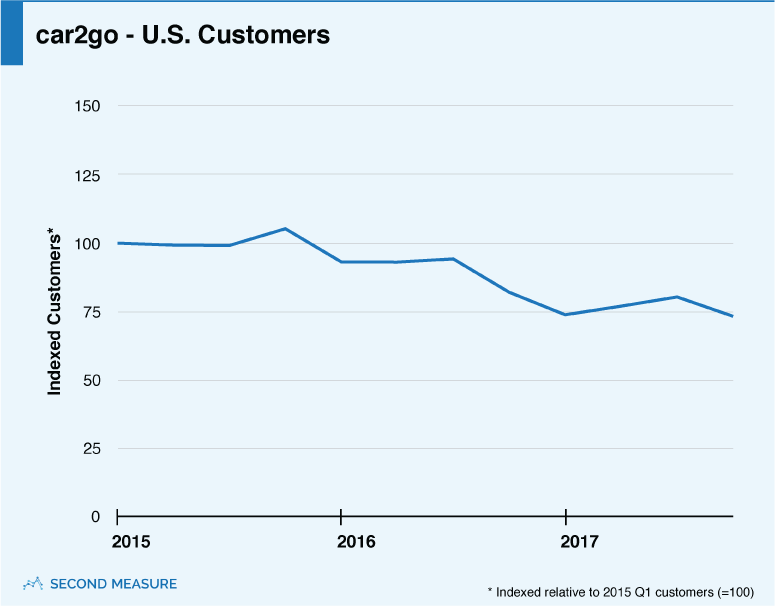
Has the expansion of car share run its course?
Car2go’s twist on an established service sets it apart from other companies, but car share is nothing new. One of the best-known names in the industry, Zipcar, has been around since 2000, allowing users to rent a car by the hour before returning it to the point of origin. And more recent entrants—like the peer-to-peer service Getaround—have attracted major funding.
Zipcar is still the dominant car-share company—its 2017 sales were more than 20 times greater than Getaround’s. But Getaround has been growing, with an 8-percent increase in year-over-year sales in 2017. Zipcar, on the other hand, is showing the reverse trend—sales were down 17 percent over the same period. Both companies exhibit elevated sales in Q2 and Q3, a seasonal trend seen across car rental companies.
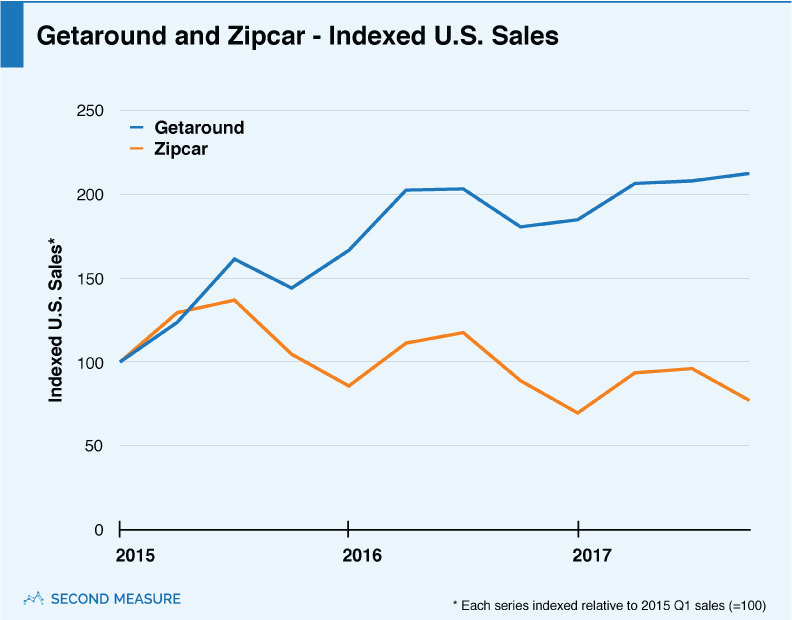
Zipcar’s post-recession heyday coincided with a decline in car ownership and a belief that car share was the future for us all. The major rental companies also started experimenting with car share back in 2008, creating programs like Enterprise Car Share (formerly We Car) and Hertz 24/7 (formerly Connect by Hertz). But as of last year, car ownership is reportedly on the rise again, meaning ideal car share markets are possibly not spreading across the country as rapidly as once predicted.
Car share creates profit when vehicles are consistently utilized, which requires a dense and car-less customer base, as might be found in large cities or on college campuses. Despite Enterprise’s immense fleet and more than 7,700 locations worldwide, the largest rental-car brand has set up shop for car share in only a limited number of markets: Enterprise Car Share hubs exist in only 17 U.S. cities.
Is the “Airbnb of car rentals” about to rev up?
Hourly rental windows are a major convenience of car share, but one company on the rise doesn’t offer them and was still dubbed the Airbnb of car rental. Peer-to-peer service Turo targets tourists and, like Airbnb, aims to foster “connections” between owners and renters. For those tired of hauling themselves around in soulless rentals, the immersive travel experience of driving a car with a story can finally be a reality.
Before Turo started brokering connections, it just brokered cars as RelayRides after receiving its angel round of funding in 2009. In 2015, the company hit its Series C funding and changed its name to Turo. The year of its rebrand, Turo’s share of sales was just 0.3 percent against established brands Enterprise, Hertz, Avis, and Budget. Two years later, Turo received Series D funding and sales have more than tripled, giving it a boost to nearly 1 percent share of sales. Like other rental brands, Turo’s sales show a seasonal pattern.
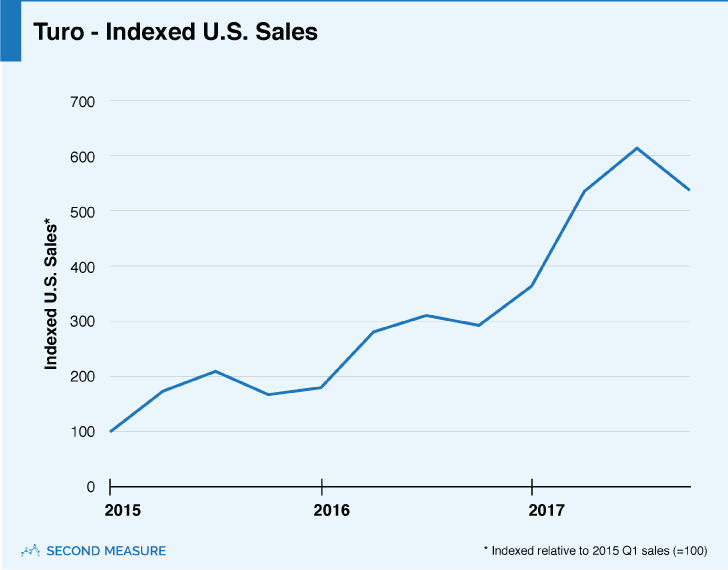
But is Turo on course to become the Airbnb of car rental? Airbnb was first funded around the same time as RelayRides, receiving its seed round of funding in 2009. Five years later, it was in its Series D and commanded 7 percent share of sales against its four largest competitors, which encompass dozens of different hotels. By 2017, Airbnb had 20 percent share of sales.
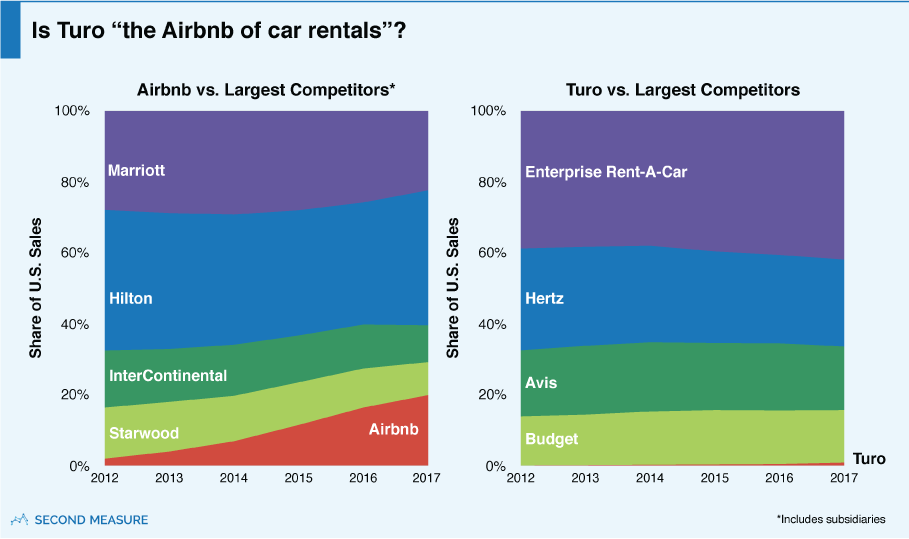
Enterprise Rent-A-Car has 42 percent share of sales among the top four rental competitors and Turo, and it dominates the rental industry with its enormous fleet purchased in bulk at below-market prices. Paying less for its cars gives Enterprise an edge over other traditional competitors with smaller fleets. But Turo’s edge is that it doesn’t maintain a fleet, instead shifting the costs of vehicle purchase and upkeep to its peer-to-peer network.
In doing so, Turo also shifts risk. Horror stories aside, even mundane driving is inherently dangerous, creating a major deterrent against listing a car with any peer-to-peer service. While Turo promises insurance coverage on the vehicles its drivers rent, resolving a fender-bender claim is still a hassle most car owners would prefer to avoid.
If Turo manages to scale up enough to compete with the major rental companies, it may need to fend off other car services once autonomous vehicles enter the market. It’s no secret that, with drivers out of the picture, ride- and car-share models will start to collide. If you take a peek under the industry’s hood, it’s already started. Avis purchased Zipcar back in 2013. Two years later, Enterprise started renting its cars to Uber drivers. When that partnership ended last year, Uber struck similar deals with Zipcar and Getaround. And car2go’s parent, Daimler? It was a lead investor in Turo’s latest funding round.
What’s around the corner for car share? Request a demo to find out!
Oh, and we’re hiring.
